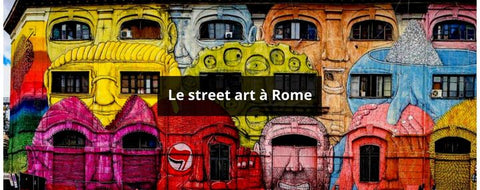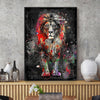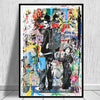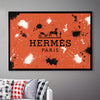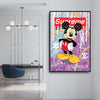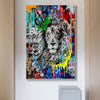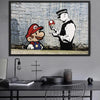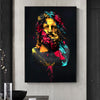
Japanese Street Art
Would you like to know everything about Japanese street art? Japanese street art is an artistic movement that fascinates many people. It developed in the streets towards the end of the 19th century. It is characterized by geometric shapes and vibrant colors, making Japanese murals some of the most beautiful in the world.
Passionate about this art, we have focused on Japanese urban culture.
In this article, you'll learn more about everything that characterizes Japanese street art, the most renowned street artists in Japan, and the highlights of Japanese street art. By the end of this article, nothing about Japanese urban art culture will surprise you anymore.

I) What are the characteristics of Japanese street art?
Street art has certainly spread around the world since its emergence in the early 1900s. In Japanese streets , one can find works by numerous artists adorning the walls. Japanese street art encompasses several techniques, including graffiti, stencils, stickers, installations, and mosaics.

A) The birth of Street Art in Japan
From antiquity onward, writing on walls was the simplest way for people to express their thoughts and imaginations. In the 1910s, numerous paintings appeared on walls in Mexico. In Russia, the art scene is primarily characterized by murals that criticize government policy and express opinions on social and economic issues.
This art form then appeared in the United States in the 1960s and in France in the 1980s. From there, street art spread throughout the rest of the world. Its arrival in Japan was somewhat later than in Europe, America, and other Asian countries.

B) Japanese urban culture
It's worth noting that street art was not traditionally part of Japanese culture. Today in Japan, street art is considered an act of vandalism or sabotage of the public spaces that abound in cities. Nevertheless, even today, artists do not hesitate to take significant risks to express their talents on Japanese walls . Indeed, this practice is severely punished under Japanese law. Artists can face sentences ranging from 21 days to five years in prison.

C) The manhôru, a symbol of Japanese street art
Also known as " manhole cover art ," manhōru emerged in Japan in the 1980s. In an effort to encourage people to connect their homes to the public sewer system, manhole covers underwent a form of improvement. They began to be personalized, making them more attractive and enticing people to purchase them.
Today, approximately 13,000 different types of manhole covers can be found on Japanese streets. They are now considered art collectors and are often sold at auction. It's also worth noting that each design on a manhole cover often has a specific meaning. This is the case for certain Japanese cities , which are easily recognizable simply by observing the symbols on their manhole covers. These symbols are often linked to a historical event that has significantly impacted the city.

II) Japanese Street Artists
Even though street art on Japanese walls is now heavily penalized by law, some artists have nonetheless risen to the ranks of the best street artists. This is due to the results of their work in this art form. Others have achieved international renown and become known throughout the world. Here are some of the most recognized street artists in the world.
A) Suiko, the Japanese street artist conquering the world
One cannot discuss Japanese street art without mentioning the name Suiko. Indeed, he is one of the leading figures in this field worldwide. Passionate about street culture from a young age, he adopted the pseudonym Suiko towards the end of his third year of Fine Arts studies at Hiroshima City University. The beginning of Suiko's career was primarily marked by his participation in the major X-Color exhibition.
This is how he came to the public's attention and began receiving requests for other exhibitions. Suiko became one of the most sought-after characters for major brands such as Adidas, Coca-Cola, Ecko Unltd, NumLock, New Era, and many others. However, it's worth noting that walls aren't the only medium the artist uses for his work. He is also capable of creating his artwork on wooden panels as well as canvases.

B) Shiro, the aerosol reindeer
We can't talk about the greatest street artists without mentioning the renowned Japanese artist Shiro . Shiro is a nurse who entered the world of street art in 1998, giving her a significant advantage over other artists in her field. For her creations, she primarily uses spray paint and other tools. Thanks to her experience, her work is undoubtedly unique. Today, her art is gaining recognition, allowing her to travel the world, including to New York, and showcase her talents as an urban artist .

C) Yumanizumu the Street artist from Tokyo
Yumanizumu is a renowned Japanese artist from Tokyo. Like other legends, Yumanizumu is now in demand worldwide. In 2011, he was invited to participate in the "A Word Of Art Artist Residency" program, an event that brought together numerous graffiti artists from around the globe in South Africa to exhibit some of their work . Among Yumanizumu's exhibitions are "Paste Street Exhibition," "Art Soweto," and "In To You."

III) The highlights of Japanese Street Art
Street art is practiced in several Japanese cities. However, despite the penalties imposed on this practice, some cities are teeming with graffiti by street artists. These are primarily Kobe, Osaka, and Tokyo.
A) Kobe, a colorful city
The port city of Kobe is among the major cities boasting some of the greatest street art . In fact, most of these works were by the contemporary artists Pow! Wow!
In Kobe, you'll find three of their works in the city center and another at the port. It's worth noting that while some pieces are in plain sight, others are well hidden behind buildings and even in less frequented neighborhoods. They are only visible to those who know where they are or who are very observant and have a keen eye for color. Therefore, Kobe is one of the great cities to visit if you're passionate about urban art .

B) Osaka, a hub for Street Art
The city of Osaka is also teeming with graffiti by Japanese artists. However, compared to other cities, Osaka strives to maintain a clean image. Indeed, all artwork and graffiti in this city must adhere to strict regulations. Paintings on walls, or any other surface, that violate these rules are immediately cleaned or painted over.
America-Mura, also known as Amemura, is the city's main district, brimming with countless examples of these works of art. They can be found everywhere: on walls, lampposts, shops, and more. In the evenings, after the shops close, you'll be sure to admire the beautiful works of the artists. Among them is the large mural "Peace on Earth," created in 1983 by the artist Seitaro Kuroda.

C) Tokyo, the Japanese capital of Street Art
Although one might imagine it, despite Tokyo being teeming with numerous exceptional street art pieces and graffiti , cleanups are frequent. Indeed, representations intended to convey a message are strictly prohibited. It's worth noting that in 2020, the Tokyo Olympics prompted the government to clean up a large portion of these works.
However, some neighborhoods in the city remained untouched by this massive government cleanup. These areas offer a glimpse into urban art. They include Harajuku, Shibuya, and Shinjuku.

You now know more about the Japanese street art : its origins, its various artists, and its particularities. You can start planning visits today to these iconic locations of Japanese urban culture.
If the street art you Please, you You can now buy an urban canvas to beautify your walls without having to travel to Japan.
See you soon.
The Lofty Trend Team.





